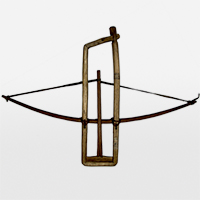アイヌと琉球
-

仕掛け弓 ロシア・沿海地方(民族名不詳) 19世紀 黒龍江地学協会寄贈
本館 16室
2019年2月26日(火) ~ 2019年6月2日(日)アイヌ文化は13世紀以降サハリン・千島・北海道・北東北のアイヌの人びとが狩猟や漁撈、植物採集に加え、アムール川下流域や沿海州そして本州の和人と交易をもちつつ育んできた独自の文化です。今回はアイヌの人びとが日々の暮らしの中で用いた狩猟や漁撈の道具、調理や機織の道具などを展示し、その生活を紹介します。
琉球王国は15世紀以降南西諸島を治め、中国や日本そして朝鮮半島や東南アジアと関係を結ぶなかで、独特な文化をつくりあげました。今回は琉球王国のなかでも第二尚氏時代を中心とした工芸作品のうち漆器と染織を展示します。
アイヌ
| 指定 | 名称 | 員数 | 作者・出土・伝来 | 時代・年代世紀 | 所蔵者・寄贈者・列品番号 | 備考 | |
| おすすめ | 家(チセ)模型 | 1軒 | 北海道アイヌ | 19世紀 | ウィーン万国博覧会事務局引継 K-25646 | ||
| おすすめ | アイヌ帯織機 | 2組 | 北海道アイヌ | 19世紀 | ウィーン万国博覧会事務局引継 K-25872 | ||
| 布織機用筬 | 1個 | 北海道アイヌ | 19世紀 | 徳川頼貞氏寄贈 K-27732 | |||
| 上下糸分離機 | 1個 | 北海道アイヌ | 19世紀 | ウィーン万国博覧会事務局引継 K-25873 | |||
| 織機用梭 | 1個 | 北海道アイヌ | 19世紀 | 徳川頼貞氏寄贈 K-28021 | |||
| 機箆 | 1個 | 北海道アイヌ | 19世紀 | 徳川頼貞氏寄贈 K-27713 | |||
| 巻棒 | 1本 | 北海道アイヌ | 19世紀 | 徳川頼貞氏寄贈 K-27736 | |||
| 糸巻 | 1個 | 北海道アイヌ | 19世紀 | 徳川頼貞氏寄贈 K-28608 | |||
| 糸巻 | 5個 | 北海道アイヌ | 19世紀 | 日本アジア協会寄贈 K-25880 | |||
| アットゥシ布 | 1反 | 北海道アイヌ | 19世紀 | 毛利昌教氏寄贈 K-27533 | ~2019年4月14日 | ||
| アットゥシ布 | 1反 | 北海道アイヌ | 19世紀 | K-39116 | 2019年4月16日~ | ||
| マキリ(小刀) | 1個 | 北海道アイヌ | 19世紀 | ウィーン万国博覧会事務局引継 K-25832 | |||
| マキリ(小刀) | 1個 | 北海道アイヌ | 19世紀 | 徳川頼貞氏寄贈 K-27679 | |||
| タシロ(山刀) | 1口 | 北海道アイヌ | 19世紀 | 徳川頼貞氏寄贈 K-27793 | |||
| 弓 | 1本 | 北海道アイヌ | 19世紀 | ウィーン万国博覧会事務局引継 K-25809 | |||
| 矢筒・矢 | 1組 | 北海道アイヌ(太櫓) | 19世紀 | ウィーン万国博覧会事務局引継 K-25795 | |||
| おすすめ | 仕掛け弓 | 1個 | ロシア・沿海地方 (民族名不詳) | 19世紀 | 黒龍江地学協会寄贈 K-30043 | ||
| ヤス | 1本 | 北海道アイヌ | 19世紀 | 農商務省北海道事業管理局寄贈 K-25765 | |||
| ヤス | 1本 | 北海道アイヌ | 19世紀 | ウィーン万国博覧会事務局引継 K-25767-1 | |||
| 釣具 | 1組 | 北海道アイヌ | 19世紀 | 徳川頼貞氏寄贈 K-28078 | |||
| 釣具箱 | 1組 | 北海道アイヌ | 19世紀 | K-27491 | |||
| 銛頭 | 1個 | 北海道アイヌ | 19世紀 | ウィーン万国博覧会事務局引継 K-25782 | |||
| 銛頭 | 1個 | 北海道アイヌ | 19世紀 | K-28812-1 | |||
| マレク(サケ漁用の銛) | 1本 | 北海道アイヌ | 19世紀 | ウィーン万国博覧会事務局引継 K-25770 | |||
| ヤマテ(イカ漁用の釣具) | 1組 | 北海道アイヌ | 19世紀 | ウィーン万国博覧会事務局引継 K-25785-1 | |||
| 内耳土器 | 1個 | ロシア・サハリン州ピェルヴァヤ・パーチ コルサコフ地区出土 | 14~16世紀 | J-8054 | |||
| おすすめ | 吊耳鉄鍋 | 1個 | 北海道アイヌ | 19世紀 | 農商務省北海道事業管理局寄贈 K-25924 | ||
| 杓子 | 1個 | 北海道アイヌ | 19世紀 | K-25826 | |||
| 椀 | 1個 | 樺太アイヌ | 19世紀 | 徳川頼貞氏寄贈 K-28629 | |||
| 匙 | 2個 | 北海道アイヌ | 19世紀 | 平子はつ氏寄贈 K-38380 | |||
| 煙草入 | 1個 | 北海道アイヌ | 19世紀 | 徳川頼貞氏寄贈 K-27774 | 2019年4月16日~ | ||
| 煙草入 | 1個 | 北海道アイヌ | 19世紀 | 徳川頼貞氏寄贈 K-27764 | ~2019年4月14日 | ||
| 煙管 | 1本 | 北海道アイヌ | 19世紀 | 徳川頼貞氏寄贈 K-28030 | 2019年4月16日~ | ||
| 煙管 | 1本 | 北海道アイヌ | 19世紀 | 徳川頼貞氏寄贈 K-28029 | ~2019年4月14日 | ||
| 火打道具入 | 2組 | 北海道アイヌ | 19世紀 | ウィーン万国博覧会事務局引継 K-25687 | |||
| 火打袋 | 1個 | 樺太ウィルタ | 19世紀 | 徳川頼貞氏寄贈 K-27869 | ~2019年4月14日 | ||
| 火打用具入 | 1個 | 北海道アイヌ | 19世紀 | ウィーン万国博覧会事務局引継 K-25688 | 2019年4月16日~ | ||
| アットゥシ(樹皮衣) | 1領 | 北海道アイヌ | 19世紀 | 平子はつ氏寄贈 K-38340 | ~2019年4月14日 | ||
| 木綿衣 | 1領 | 北海道アイヌ | 19世紀 | 徳川頼貞氏寄贈 K-27882 | ~2019年4月14日 | ||
| アットゥシ(樹皮衣) | 1領 | 北海道アイヌ | 19世紀 | K-38654 | 2019年4月16日~ | ||
| 木綿衣 | 1領 | 北海道アイヌ | 19世紀 | 徳川頼貞氏寄贈 K-27887 | 2019年4月16日~ |
琉球
| 指定 | 名称 | 員数 | 作者・出土・伝来 | 時代・年代世紀 | 所蔵者・寄贈者・列品番号 | 備考 | |
| 葡萄栗鼠螺鈿小箱 | 1合 | 沖縄本島 | 第二尚氏時代・18世紀 | H-617 | ~2019年4月14日 | ||
| 茶庫 | 1組 | 沖縄本島 | 第二尚氏時代・19世紀 | H-3575 | 2019年4月16日~ | ||
| おすすめ | 楼閣人物螺鈿八角壺 | 1口 | 沖縄本島 | 第二尚氏時代・17世紀 | H-4501 | 2019年4月16日~ | |
| 紅型衣装 紺地三階菱繋花模様 | 1領 | 沖縄本島 | 第二尚氏時代・19世紀 | I-2829 | ~2019年4月14日 | ||
| 紅型衣装 浅葱麻地草花模様 | 1領 | 沖縄本島 | 第二尚氏時代・19世紀 | I-3486 | 2019年4月16日~ |
